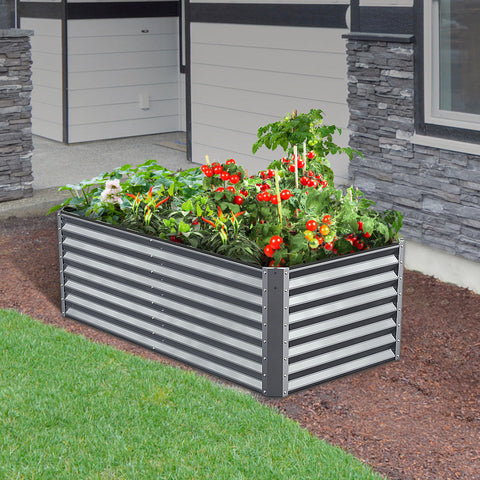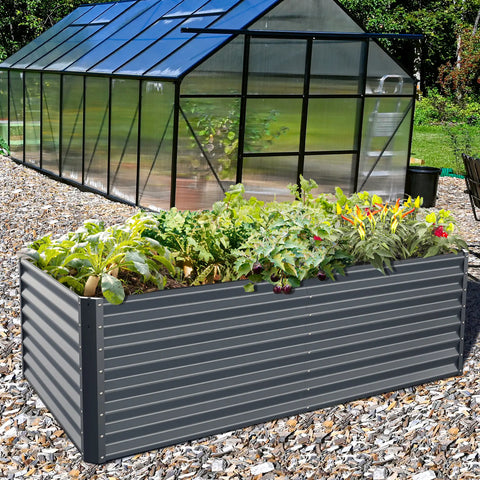A raised garden bed is a popular choice in garden design, which not only adds beauty but also improves the growing conditions of plants. However, a common question is: How big should a raised garden bed be? Determining the size of a garden bed is an important decision that involves multiple factors such as space utilization, plant needs, ease of access, and aesthetic effects. This article will delve into the ideal size of a raised garden bed to help you make informed decisions when planning and designing your garden. Whether you want to create a small, delicate garden corner or want to create a spacious and diverse plant world, this article will provide you with valuable guidance and advice. Let's explore together to find the perfect raised garden bed size for you.

Space and site constraints are key factors in determining the size of raised garden beds.
1. Plan and utilize available space: When deciding on the size of your raised garden bed, consider the available space in your garden first. Measure and evaluate the area you can use to raise your garden bed, including length, width and height. Plan and use the available space properly, taking into account the needs of other garden elements and paths.
2. Consider the overall size of your yard: Consider the size and size of your entire yard. If your yard is smaller, a larger size raised garden bed may take up too much space and make the yard appear crowded. In the limited space, choose the appropriate raised garden bed size to allow space for other activities and elements.
3. Consider the surrounding environment and functional needs: Observe the surrounding environment and functional needs of the courtyard. For example, if your yard needs to allow enough space for outdoor furniture, children's play, or other functional areas, the size of the raised garden bed should be reduced to maintain a reasonable patio layout.
4. Consider sun exposure and ventilation: Consider the impact of the size of the raised garden bed on sun exposure and air circulation. Make sure that the size of the garden bed does not block the arrival of sunlight, and that there is good ventilation in the courtyard. Adjust the location and size of raised garden beds according to the orientation of the courtyard and the light needs of the plants.
5. Be flexible to adjust and experiment: Stay flexible and try different garden bed sizes according to your actual situation. In the beginning, smaller raised garden bed sizes can be selected to accommodate space constraints, and adjusted and expanded as experience and observation results.
By considering space and site constraints, you can determine the size of a raised garden bed suitable for a patio. A comprehensive assessment of your yard size, environment, functional needs and other factors to work out a reasonable raised garden bed size to create a beautiful and functional garden area in a limited space.

Garden design and layout is another important aspect in determining the size of a raised garden bed
1. Define the purpose and style of the garden: First, define the purpose of the garden and the desired style. Determine whether the garden will be used to grow vegetables, herbs, flowers, or a combination of multiple functions. Also consider the overall style of the garden, such as modern, traditional, natural or Japanese courtyard style, to ensure that the raised garden bed harmonized with the overall design style.
2. Consider plant needs and space: Understand the needs and space requirements of the plants you plan to grow. Certain plants need a larger space to grow, while others can grow well in a smaller garden bed. Consider the height, root spread and width of the plants, as well as their growth rate and space use to determine the size and shape of the raised garden bed.
3. Allow enough walking space: When designing a raised garden bed, allow enough walking space so that you can easily access and manipulate the plants in the bed. Depending on the size and location of the garden bed, ensure that the walking space around the garden bed is spacious and comfortable, easy to manage and maintain.
4. Consider the shape and layout of the garden bed: Choose the appropriate shape and layout of the garden bed according to the overall design of the garden. Common raised garden bed shapes include rectangles, squares, circles and arcs. Consider the impact of the shape of the garden bed on the aesthetics of the garden and how to maximize the use of the available space.
5. Incorporate other garden elements: When laying out the garden bed, consider the coordination and integration with other garden elements. Raised garden beds are combined with other flower beds, paths, seating areas and water features to create a unified, harmonious garden design. Ensure that the size and placement of the garden bed complements and balances the other elements.
6. Consider sustainability and future development: When designing a raised garden bed, consider future development and sustainability. Reserve some space to expand the size of the garden bed or add other garden elements in the future. At the same time, ensure that the design and layout of garden beds comply with sustainable farming and management principles in order to maintain the health and beauty of the garden in the long term.
By taking into account the garden's use, style, plant needs, walking space, shape and layout, and coordination with other garden elements, you can design the ideal raised garden bed size for your garden. Flexibility to adapt and experiment with different design options to suit your personal preferences and garden needs.

Ease of access and maintenance is also an important aspect in determining the size of a raised garden bed
1. Make sure you have enough work space: When designing a raised garden bed, make sure you have enough work space around you. This gives you easy access to the garden bed for planting, management and maintenance. Adequate work space provides a comfortable operating environment and reduces the risk of mishandling and damage to plants.
2. Consider ergonomics: When laying out a garden bed, consider ergonomic principles so that they conform to the natural flow of human posture and movement. Reduce the frequency of bending, squatting, and stretching to reduce stress and discomfort in the body. Adjust the height and width of the garden bed so that it is suitable for your height and comfortable operation.
3. Ensure good access and access paths: To facilitate access and maintenance of raised garden beds, ensure that there are good access and access paths around them. These paths can be garden paths, flagstone paths, or paved steps, allowing you to easily reach parts of the garden bed without damaging other plants or soil.
4. Consider mobility and portability: If you want to be able to move or rearrange your garden bed, choose a relatively small, lightweight raised garden bed design. This makes it easier for you to move the position of the garden bed, to adapt to different seasons or layout needs, or to undertake an overall replanning of the yard.
5. Simplify maintenance and management tasks: When designing raised garden beds, consider reducing the complexity of maintenance and management. Make sure the garden bed is a size and shape that can accommodate your maintenance capacity and time. Choose plant combinations and layouts to reduce the frequency and effort of routine tasks such as weeding, pruning, and sprinkler irrigation.
6. Get the right tools and equipment: For easy access to and maintenance of raised garden beds, get the right tools and equipment. For example, choose garden tools of the right length and size, such as garden shovels, hoes, and sprinkler irrigation equipment, so that you can easily work on the garden bed.
By considering access and maintenance convenience, ensuring adequate work space, ergonomic principles, good access paths, mobility and portability, simplifying maintenance tasks, and being equipped with the right tools and equipment, you can create a raised garden bed that is easy to access and maintain. This way, you'll be able to easily manage, harvest and maintain your plants, and keep your garden bed clean and healthy.

Through the discussion of this article, we have a deep understanding of the ideal size choice of raised garden bed. We learned that determining the size of a garden bed requires a combination of factors such as space and site constraints, garden design and layout, ease of access and maintenance, as well as aesthetics and visual effects.
When deciding on garden bed size, it is crucial to pay attention to the proper use of space and the growing needs of plants. Make sure the size of the garden bed is in harmony with the overall garden design and leave enough walking and operating space for easy access and maintenance. At the same time, consider the height, color and combination of plants, as well as the choice of shapes and lines to enhance the aesthetic effect of the garden.
The most important thing is to weigh personal preferences and actual needs when choosing the size of a raised garden bed. Each garden is unique and special, so the most suitable size may vary from person to person. Depending on your space, time and interests, choose a raised garden bed size that meets your planting goals and aesthetic expectations.
Whether you choose a small and delicate garden bed or a spacious and varied plant space, the most important thing is to enjoy the process and results of the garden. With proper planning and careful design, you can create a raised garden bed that is pleasing, beautiful and practical. May your garden bed become an extension of your unique creativity and green dreams, bringing you joy and satisfaction. Start planning and make your garden bed a paradise of flowers!









